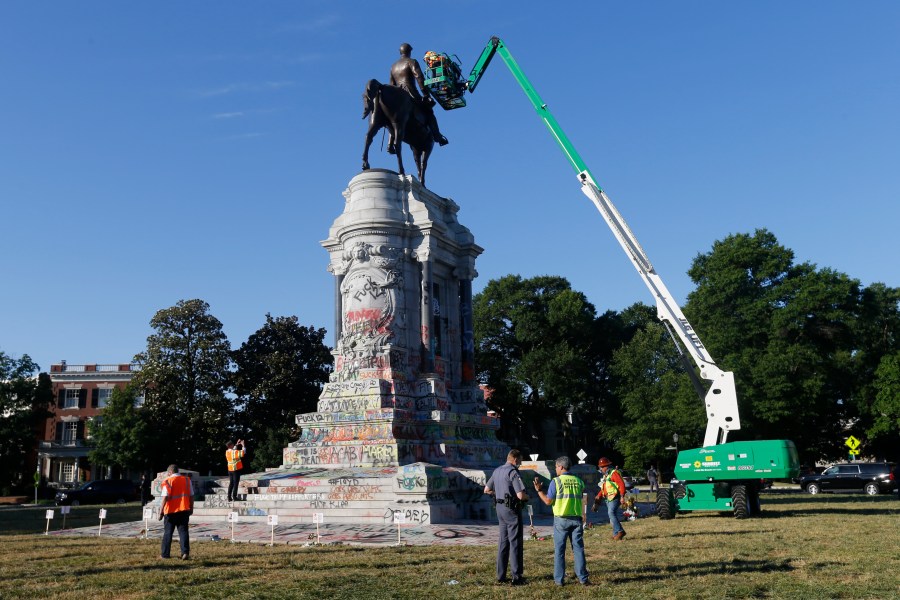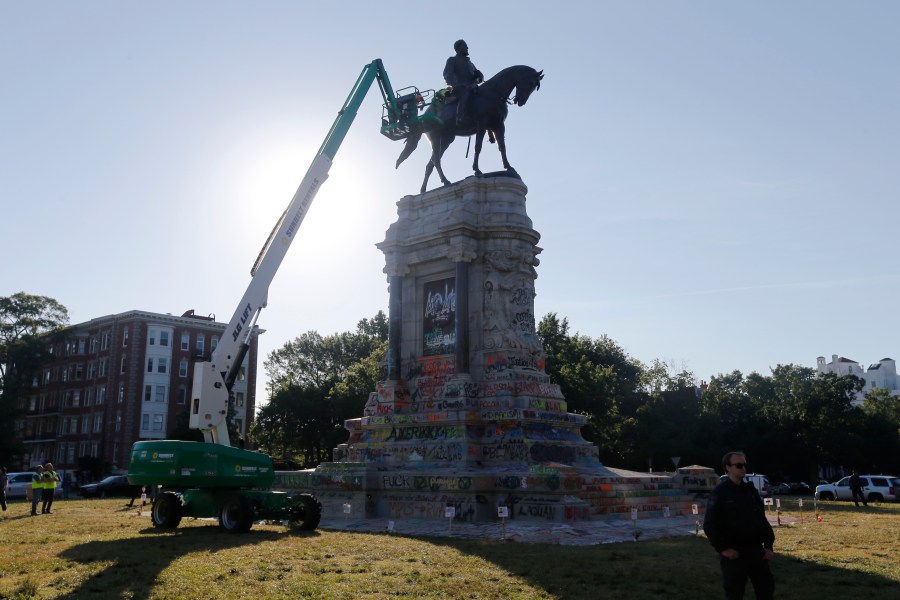RICHMOND, Va. (AP) — Workers for the state of Virginia inspected Richmond’s huge statue of Gen. Robert E. Lee on Monday before its planned removal. While protesters have toppled some other Confederate statues and some cities have moved swiftly to remove what critics see as symbols of white supremacy, this monument won’t be so easy to take down.
Virginia’s Department of General Services said in a statement that it plans to remove the statue of the Confederate general on a date to be determined, as soon as possible. But officials said it must be done safely, given the memorial’s weight and height.
“The massive statue weighs approximately 12 tons, stands 21 feet tall, and has been on a 40-foot pedestal for 130 years,” the agency said in a statement. “Meticulous planning is required to remove an aging monument of this size and scale safely.”
Virginia Gov. Ralph Northam ordered the removal of the Lee monument last week amid nationwide protests sparked by the death of George Floyd, a black man in Minneapolis who died after a white officer jammed his knee into his neck for nearly nine minutes.
Motivated by a bystander’s video of Floyd’s agony, demonstrators around the world have vowed to sustain a movement focused on addressing racial injustice and police brutality. In the American South, they’re also advocating for the swift removal of Confederate monuments, with or without the approval of authorities.
Opponents of the monuments say they celebrate white supremacy and gloss over the nation’s history of slavery. Others who advocate for keeping them say they have historical or artistic value and their removal amounts to erasing history.
Authorities have removed other symbols since protests erupted two weeks ago, including a massive obelisk in Birmingham, Alabama, and a bronze likeness of Admiral Raphael Semmes that had stood in a middle of a downtown street near the Mobile, Alabama, waterfront for 120 years. In Fredericksburg, Virginia, a 176-year-old slave auction block was removed from the city’s downtown, and the United Daughters of the Confederacy removed its statue from Old Town, Alexandria.
In other cases, protesters aren’t waiting: In Richmond over the weekend, protesters toppled a statue of Gen. Williams Carter Wickham in a park near downtown, and in Bristol, England, a statue of slave trader Edward Colston met a watery end.
In Kentucky’s largest city on Monday, a city crew swiftly dismantled a statue depicting John Breckenridge Castleman on horseback, acting decisively after a court ruling Friday that followed nearly two years of legal wrangling and vandalism. Castleman was a Confederate soldier and later a U.S. general who helped found Louisville’s park system, but has also been a symbol of support for slavery.
“Too many people are suffering today because the promises of justice and equality enshrined in our Constitution are unfulfilled by a society that devalues African-American lives and denies African Americans justice, opportunity and equity,” Fischer said. “That’s got to change. People want and deserve action. We need a transformation.”
In New Orleans, efforts are underway to rename the city’s Jefferson Davis Parkway to instead honor former Xavier University president Norman C. Francis. The street runs along the border of Xavier, the nation’s only historically Catholic and black university, and five mayors including the current Mayor LaToya Cantrell have voiced support for the change, to be discussed at a city council meeting on June 18.
New Orleans already took down four Confederacy-linked monuments in 2017 after months of protests for and against their removal. Now some advocates want the the statue of Andrew Jackson removed from Jackson Square in front of the city’s famed St. Louis Cathedral. The statue honors Jackson’s role in defending the city during the Battle of 1812, but he also owned slaves and as president orchestrated the removal of Native Americans from their lands along the Trail of Tears.
In Richmond, the Lee statue is on state property. City leaders meanwhile have committed to taking down another four Confederate memorials on city land along Monument Avenue. Together, they are among the nation’s most prominent collection of tributes to the Confederacy, and their planned removal has been widely praised by black leaders and activists.
Police officers blocked off streets leading up to the traffic circle that surrounds the Lee statue around 7 a.m. Monday. Others ringed the monument with their vehicles.
Several top state officials, including Northam’s chief of staff, were on the scene as a cherry picker hauled in on a flat-bed truck hoisted workers up to inspect the statue. The work appeared to take only about an hour, and the scene was soon cleared.
___ Associated Press writer Ben Finley in Norfolk contributed to this report.

































